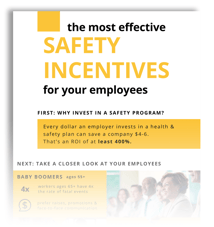With National Safety Month just around the corner, now is the time to get your safety program in place and understand how it can affect your bottom line.
Observed annually in June, National Safety Month focuses on reducing the leading causes of injury and death at work. In 2017, there were 5,147 work fatalities, with an average of more than 14 deaths every day, and nearly 3 out of every 100 employees were injured or became ill at work. A safety program is a business’s way of focusing on safety year-round to prevent and reduce these numbers with effective training, procedures, and reporting tools.
If you’re still not convinced why safety is important for businesses, here are some things to consider.
The Savings Alone Are Worth It
American businesses spend $170 billion annually paying out claims related to workman’s compensation and work-related injuries. According to OSHA, that figure can be reduced by 20-40% when businesses have an established safety program. The reduction in cost from a safety program is a significant saving and can represent the difference between being profitable and breaking even. It can represent the difference between hitting a workforce retention rate and spending even more on-boarding new employees.
Safety programs can recognize returns on investment of 400% or more, according to Inspirus. That means for every dollar an employer puts into a safety program, they can save four to six dollars. If there are concerns about making initial investments in incentives, or process changes related to safety programs, understand what the return could look like at your organization. Quantify what your organization could do with that savings and the impact it would have on your workforce. The impacts are not only measurable but compelling enough to get the buy-in you’re looking for.
You Will Succeed with Participation
The question on many managers’ minds is: how can you ensure your program is effective? Don’t let this question keep you from implementing something as crucial as a safety program.
Like any employee initiative, if your employees aren’t engaged in the program, it is less likely that your organization will realize ROI. Participation rates are critical. Canadian firm eCompliance emphasizes employee participation through both executive buy-in at the highest levels of the company, and a commitment from front-line manager. If management at an organization is endorsing a program, employees are more likely to participate. Some of that has to do with employees doing as their manager does, but most importantly, a program endorsed at multiple levels of an organization validates its benefits.
Another easy way to boost participation rates is to incorporate incentives into the employee experience of the program. Small rewards, like gift cards, for a personal safety record can start a program’s momentum. Scaling that record to encourage a team to work together toward larger incentives can scale the momentum of a safety program.
Be ready for National Safety Month this year and start thinking what you can do to design a safety program that gets your employees excited about participating—not only for the safety of your employees, but for the future of your business.
Looking for the most effective safety incentives for your employees? Learn which incentives work best for different populations with this infographic.
 Click the image to see full size.
Click the image to see full size.






